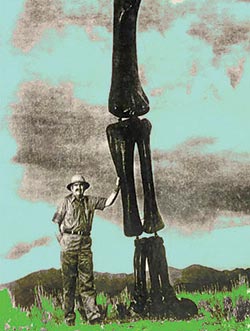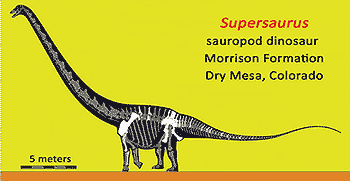 |
| The most famous image of “Dinosaur Jim Jensen” has him posed beside the giant sauropod limb which he named Ultrasaurus, later transferred to Supersaurus. |
The “paleo people” introduced in the last two issues of Moab Happenings, Elmer Riggs of Brachiosaurus fame, and Earl Douglas of Dinosaur National Monument fame, were both dino guys famous for discovering big sauropods. “Dinosaur Jim Jensen” (1918-1998) a Utah native, earned a larger than life reputation for his equally “gigantic” dinosaur discoveries. Known and admired by paleontologists who came of age in the 20th Century, he loved outdoor exploration. Unlike the standard academic he did not graduate high school and tried frontier homesteading in Alaska before returning to Utah. When he came to Denver to give a lecture in a science lab. I remember there was no glass of water on the podium, so he just went to the sink and scooped a handful from the faucet proudly saying “that’s how we do it at streams in the field.” His good friend Don Burge, for many the years the paleontologist at the College of Eastern Utah Prehistoric Museum in Price, described him as intensely curious and prone to picking up roadkill to investigate animal anatomy.
“Dinosaur Jim” had a very practical side, trained as a welder and machinist, he was also creative, an accomplished painter and sculptor in metal and stone. These skills served well when he turned to paleontology excavation and exhibits. He served a five-year, hands-on apprenticeship at Harvard’s famous Museum of Comparative Zoology as a “preparator” under the expert eye of the equally famous vertebrate paleontologist Alfred Sherwood Romer. He excavated fossils at dozens of sites, extracting them from matrix and mounting innovative in museum displays.
Returning to Utah in 1961, with the requisite 10,000 hours of training under his belt, he was qualified as a master excavator-preparator. He conducted large-scale dinosaur excavations of which the most famous produced the aptly named Supersaurus from Dry Mesa
Quarry in Colorado. Here in the in the Dinosaur Diamond region, in the bone-rich, Late Jurassic Morrison Formation “Dinosaur Jim” was following in the tradition of giant brontosaur hunters Elmer Riggs and Earl Douglas. Supersaurus, was larger than life and images of the monstrous bones, prepared for display by Jim, went viral around the global media circuit in the days when viral
 |
| Supersaurus is recognized as a valid name describing Jim Jensen’s giant Late Jurassic sauropod discovery from Dry Mesa Quarry in Colorado. |
meant glossy magazine and TV documentary coverage. Jim’s colleagues noted that his success often stemmed from local contacts familiar with the backcountry. With his charismatic public persona, Jim rode the 1970s wave of “Dinosaur Renaissance” popularity. As one report put it Dinosaur Jim eschewed publication in Science, Nature or the Journal of Vertebrate Paleontology, and told the world about his finds in the popular press including a 1973 piece in Reader’s Digest entitled “Supersaurus, the Biggest Brute Ever.” Jim also named Ultrasaurus, which for technical reasons was not accepted as a valid name. Supersaurus however has had staying power.
Jim described himself as “an adventurer who happened to wander into paleontology.” The field is richer thanks to his legacy, which includes hundreds of tons of dinosaur bones, stored beneath bleachers at the Brigham Young University football stadium. This paleontological treasure trove still keeps students busy, often revealing new types. Jim wandered into academic recognition when BYU awarded him an honorary doctorate. But he is simply remembered, as would please him, as “Dinosaur Jim.” |